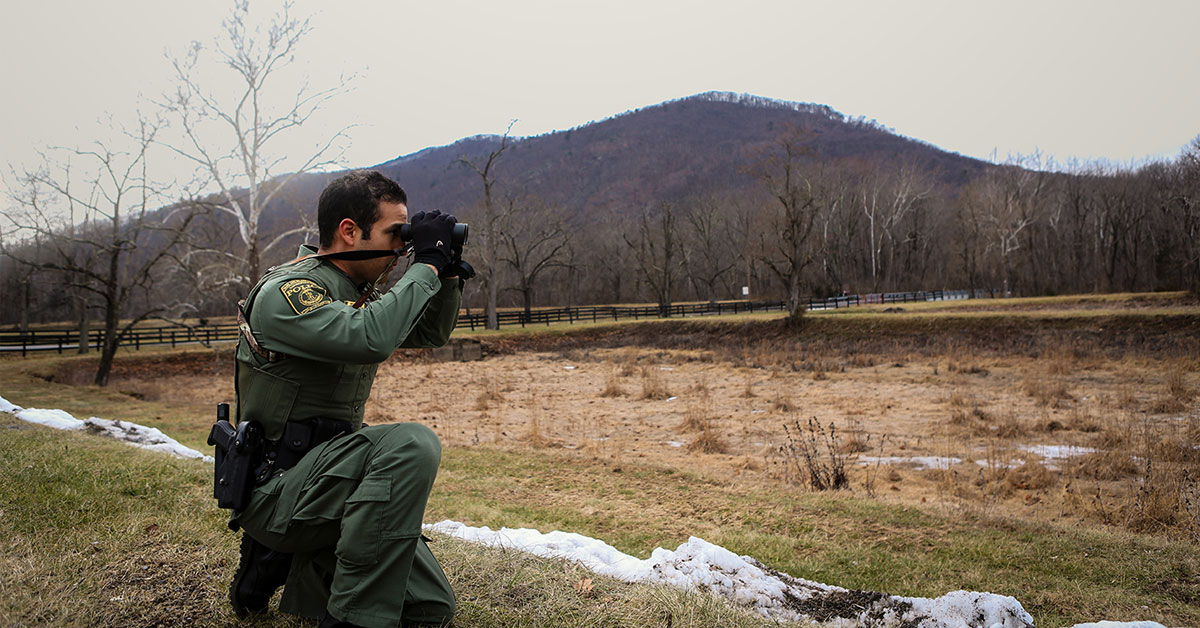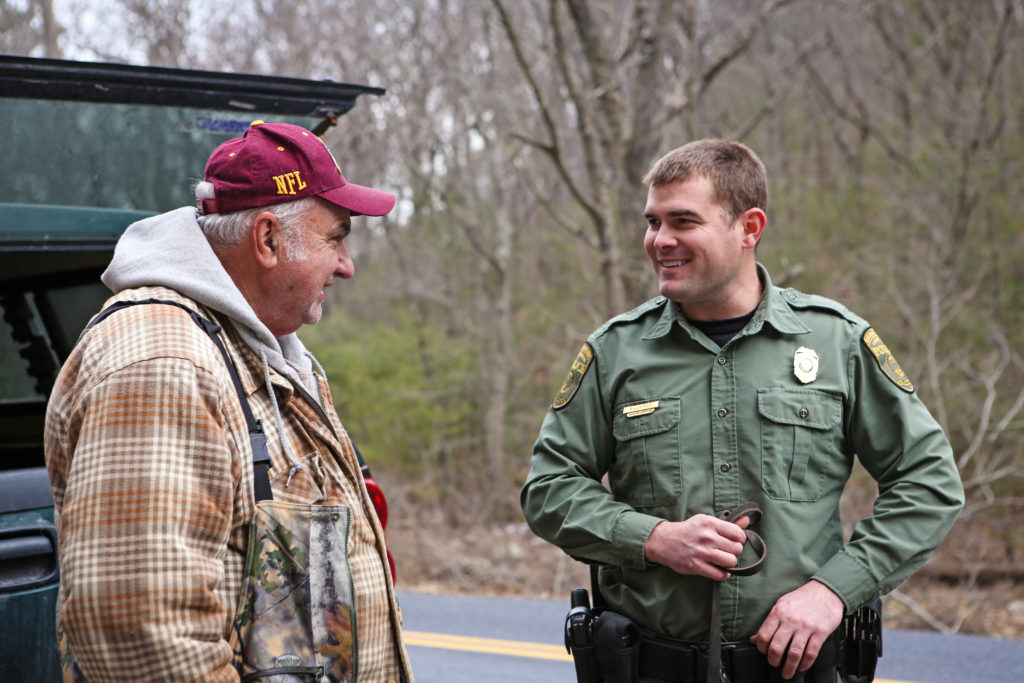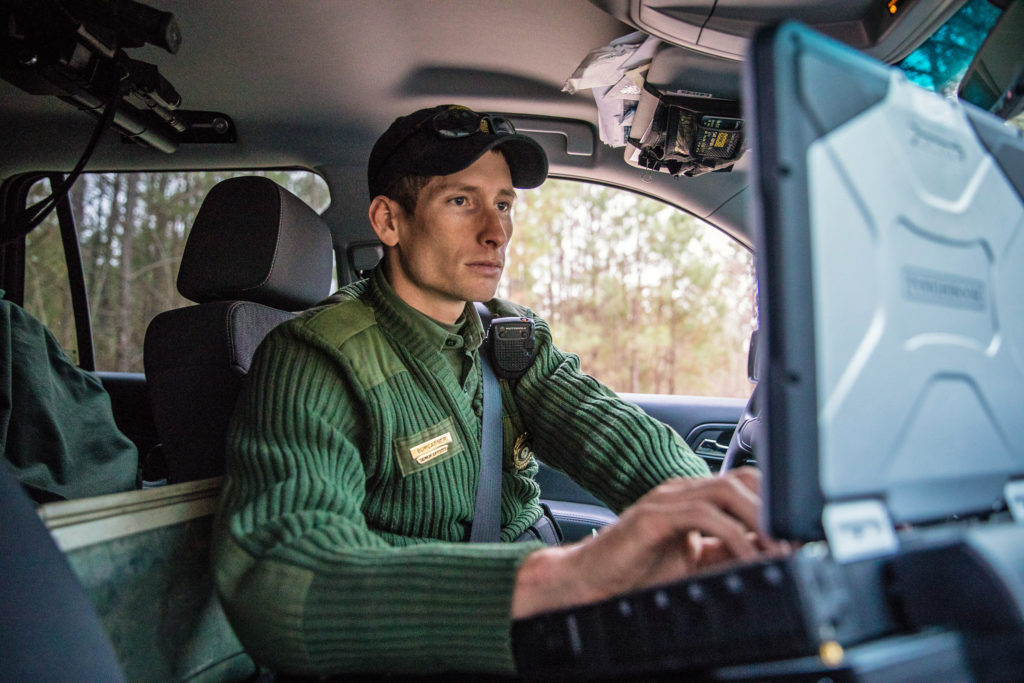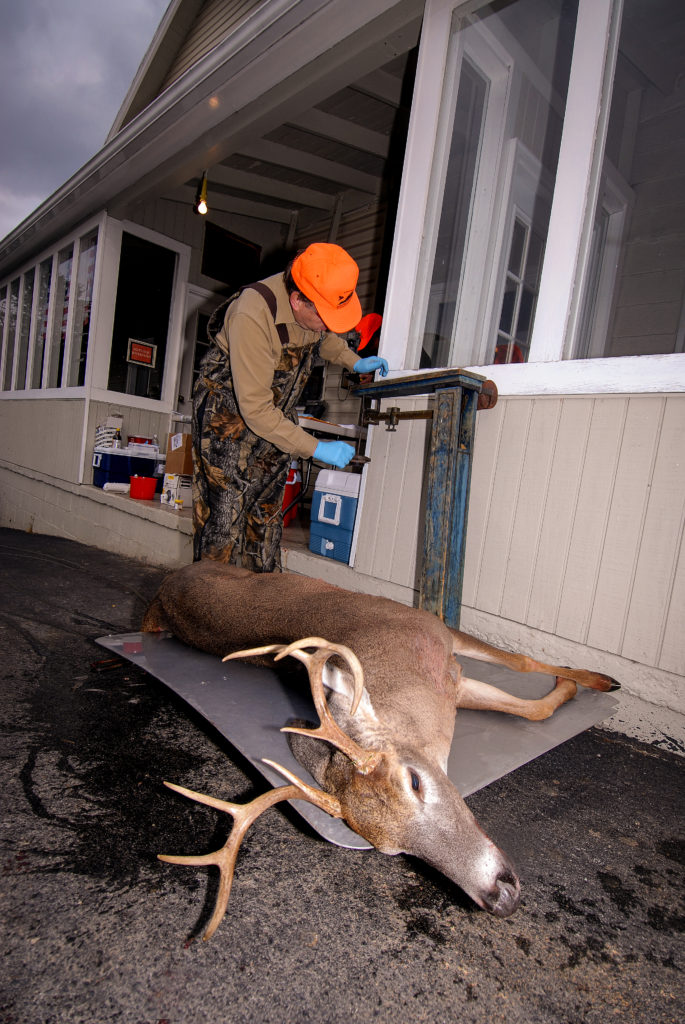Virginia’s law enforcement division of the DWR currently has 184 Conservation Police Officers (CPO’s) protecting our game and fish natural resources. The assignments and responsibilities of Conservation Officers are widespread and their service throughout our great Commonwealth has stood the test of time for over 100 years!

The Virginia CPO does not work a 9-5 job instead they work the hours that are most effective to address the hunting season that is under way.
By Major Scott Naff, Assistant Chief of Law Enforcement Operations
Photos by Meghan Marchetti
For those of us who have grown up exposed to the outdoors, whether it be through hunting, fishing, trapping or boating, at some point we either heard about the game warden or have had an encounter with a game warden. Game wardens, now called conservation police officers (CPOs), are often thought of as mystical characters that are behind a tree or bush near where you are hunting or fishing and are ready to nab you if you break a hunting or fishing law. Have you ever had that funny feeling that someone was watching you, or you’ve turned your head and been slightly startled to see a CPO standing behind you observing you hunting or fishing?
It is this level of mysteriousness about CPOs that helps to nudge some would-be violators away from breaking the law and keeps the other honest outdoor enthusiasts honest. We all know that a CPO can’t be behind every tree, but when they start their day, how do they end up being in places that perpetuate this notion?
The Virginia Department of Wildlife Resources (VDWR) law enforcement division is comprised of 184 CPOs, a communications center that is staffed with dispatchers 24/7/365, and a records section that maintains and analyzes all the reports and paperwork generated by the CPOs. With Virginia’s 8.5 million people in 95 counties, 38 independent cities, and 191 towns within its 42,775 square miles, it does not take long to realize that seeing or encountering one of those 184 CPOs is a rarity.
A CPO’s duties vary from day to day, month to month and season to season. Not unlike other police officers, CPOs receive many calls from their dispatchers in the VDWR’s communications center. When they receive these calls, they have a duty and responsibility to respond to them. CPOs also receive information directly from the public and from informants that they have developed relationships with in their counties. With advances in technology, CPOs are now getting text messages and videos sent directly to their phones, which has been effective. There is nothing like someone videoing with their cell phone someone standing in the middle of the road shooting at a deer – this makes for a quick investigation and an even quicker guilty verdict in court. Due to all the methods of information coming to a CPO, it would be easy to imagine how the best plan for a work day can be changed through a call from dispatch or a notification on a phone. Regardless, let’s look at how a CPO typically looks at their work day.

CPO’s check hunters on public and private land statewide. The officers get calls from hunters and the general public, with issues of concern at any hour of the day or night.
As stated earlier, the season affects the planning of a CPO’s work. It is important to note that CPOs do not work 9-5. They work the eight or more hours a day that they need to address the activity that is happening for that time of the year and to properly document their work through required forms and reports. Yes, paperwork is an extremely important part of the CPO’s duties. In the heat of the summer, they may work a split shift, so they can meet with farmers to issue kill permits for crop damage during the day, and then come back out in the evening checking anglers and boaters who are seeking cooler temperatures after their workday. In the fall and winter, a CPO may come out early in the morning to check hunters, then go home to be with their families, and then come back out mid-afternoon and work until after dark checking hunters and working a spotlighting patrol. Of course, Saturdays and holidays are usually so filled with activity, CPOs work very long, continuous hours. With deer season right around the corner, let’s look at an opening day of deer season for a CPO.
“The Virginia Department of Game and Inland Fisheries (DGIF) law enforcement division is comprised of 184 CPO’s, a communications center that is staffed with dispatchers 24/7/365, and a records section that maintains and analyzes all the reports and paperwork generated by the CPOs.”
It is 3:30 a.m. and the alarm goes off, the CPO quietly puts on his uniform and leaves without disturbing his family. The CPO stops by the local convenience store to grab a cup of coffee and heads before daylight to the agricultural field that is traditionally used by hunters on opening day. This field is on a popular route to public hunting land and is frequented by deer eating up the remaining soybean litter from this fall’s harvest. Stopping at the store serves a couple of purposes, coffee and being seen. The clerk will be sure to tell the early morning hunters that the CPO stopped in. This puts the CPO in their thoughts – they will be sure to check to see that they have their licenses with them and will be less likely to violate a hunting or property law.
There is much traffic by the field as hunters are heading to their favorite hunting locations, but no shining or shooting on this opening morning. As light is breaking on the horizon, the officer heads to a property where an informant reported bait scattered in front of a ground blind. As the CPO gets within two miles of the baited property, he gets a call from dispatch about a landowner with a trespasser on his property. The CPO gets the address and heads in that direction – the baited blind will have to be checked later. The trespass call is on the other side of the county and it takes the CPO 45 minutes to get there. Upon arrival the CPO is met by the landowner who is visibly upset, and he provides the CPO with a description and a vehicle license plate number. The CPO returns to his vehicle and runs the tag through the mobile computer. The plate belongs to someone from out of town. The CPO types in notes about the complaint and will keep an eye out for the vehicle. He will have to follow-up when the trespasser returns home.
Being on the other side of the county, the CPO heads to a property where a local resident reported a group from out-of-state may show up and hunt due to the recent sale of the property. The CPO arrives at the property and there are several vehicles parked at the gate with out of state tags. The CPO checks the vehicle registration information on the vehicles and then checks that information against the information in the GoOutdoors license system. There are no matches, so the CPO puts on his blaze orange cap and walks the road into the property. One hundred yards in and the CPO encounters an individual in a treestand with a rifle, not wearing blaze orange. The officer asks them to climb down to speak with them. It turns out that there are four hunters on the property and all are from out-of-state, with no hunting licenses and no blaze orange. A friend of theirs had purchased the property and told them they could hunt it. Summonses are written, and the officer provides them the information needed so they can purchase their licenses and blaze orange, so they can hunt later in the day – legally.
“A CPO’s duties vary from day to day, month to month and season to season. Not unlike other police officers, CPOs receive many calls from their dispatchers in the VDGIF’s communication center.”
When the CPO gets back in his patrol vehicle, he notices two pending calls in his county – a report of trespassing and someone with questions about hunting seasons and laws. The CPO heads to the trespassing call and on the way calls and talks to the other party to answer their questions. On the way to the trespass call, the officer sees a truck that matches the description of the vehicle that was trespassing earlier in the morning. The CPO stops the truck and speaks to the occupants about the trespassing call. They admit to being on the property and are cooperative. The CPO gets their information and will have to secure warrants later. They are sent on their way with the understanding that the CPO will be back in touch.

Technology has come a long way for conservation officers today. Vehicles equipped with computers enable the CPO to finalize reports, enter notes of the day’s activities, and send and receive emails from dispatch. The computer keeps the officer in close contact while on duty.
The CPO resumes the response to the trespass call and upon arrival he is notified that the landowner has made peace with the trespassers and does not want any enforcement action taken. The CPO clears the call and heads to the public land to check hunters as they are returning to the woods from their lunch breaks. Lunch?
The CPO contacts several hunters, checks their licenses and hears some great hunting stories from that morning. The CPO heads toward a store to grab something to eat and then tries to reach the baited blind to see if it is being hunted. As the CPO is leaving the store he is notified by dispatch that a hunter has fallen from a treestand and is seriously injured. The CPO requests assistance from a neighboring CPO and their sergeant and responds to the property where the fall occurred. The CPO stops to get his ATV to assist medical personnel in reaching the victim in a remote portion of the property. The CPO arrives, and the victim is successfully removed from the location and put in a waiting ambulance. The CPO can get some preliminary information from the victim but will have to follow-up at the hospital. The other CPOs arrive on scene and work together to get all the information needed to prepare the necessary reports. It turns out that the victim was trespassing about 200 yards from property where he had permission to be. All officers clear the scene and arrangements are made to visit the victim in the hospital the following morning to discuss the fall and the trespass violation. And then there’s the paperwork – the CPO will have to compile the witness statements, complete the hunting incident report, complete a written complaint to provide the magistrate for the trespass violation, complete notes for court and for the call for service – most of this will have to wait until tomorrow after they leave the hospital.

CPOs work big game check stations during the hunting season. Hunters have been checking their deer, bear and turkey harvests at check stations throughout the state since 1947.
It is getting close to the end of legal shooting hours and the CPO makes it to the property where the baited blind is located. There is a truck parked at the gate, so there is a good chance the blind is being hunted. The CPO puts on their blaze orange cap and eases up the path leading to the blind. BOOM! A shot goes off and startles the CPO. It is in the direction of the blind. The CPO eases a little closer to see someone exiting the blind and going to look at a deer in front of the blind. The CPO, keeping his safety in mind, takes a position behind a large oak tree where he can see the hunter. The hunter drags the deer past the tree where the CPO is standing. The CPO quietly follows the hunter back down the path for a few yards and when he knows he is in a safe position of advantage, he announces himself to the unsuspecting hunter. The startled hunter begins to tell the CPO that the deer was killed on another part of the property, but when the CPO recounts the hunter’s actions, the hunter knows he has been caught. The CPO and hunter make it back to their vehicles and the CPO issues a summons to the hunter. The hunter will tell his friends and acquaintances about the CPO that mysteriously appeared behind him after he illegally killed a deer and will further the legends of CPOs being behind every tree.
It is well after dark and with no pending calls, the CPO heads home from a very eventful opening day. The CPO pulls into his driveway and boots up his mobile computer. He completes incident reports for the summonses issued to the out-of-staters and for the baited blind. He enters notes into the computer aided dispatch system for the calls for service that were responded to. The CPO shuts down the computer and notifies dispatch by radio that he is finally off duty.
Our CPOs duties and responsibilities are so vast, that no two days are ever alike. No two opening days of any season and no two days between seasons. Our CPOs must be adaptive, creative and resourceful to be successful in not only answering all of their calls and completing all of their investigations, but to go home safely every day. Our CPOs appreciate your support, the support of the VDHA, and the support from the communities they serve.
Editor’s note: Major Scott Naff is the Assistant Chief of Law Enforcement Operations, overseeing the operations of 184 sworn officers across the Commonwealth. He is a native of Radford, Virginia, and an avid hunter, trapper and angler. Major Naff earned a master’s degree in Executive Leadership from Liberty University and a bachelor’s degree in Criminal Justice from Radford University. While in college, he worked for Claytor Lake State Park and for the VDWR as a Wildlife Worker. He began his career as a Conservation Police Officer in 1994 and served in the ranks of Area Leader, Sergeant, Academy Director, and Lieutenant before promoted to the rank of Major in 2016.


